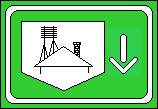|
In urban areas the telephone wires run from roofs to roofs. Before the WWs and their times above all cities were very close spider net.. On the roofs were more place for the wires than on the streets. The roof holders made from steel pipes and L profile steel crossarms with 2, 6 and 10 pins.
The 10 pins crossarms were the most common, there were more pins crossarms too, I draw 12 pins ones. I can't draw the all combinations, it is much, you can imaginainate every mixs..
Because of the easier working, the steel pipe has some steel steps.
|





